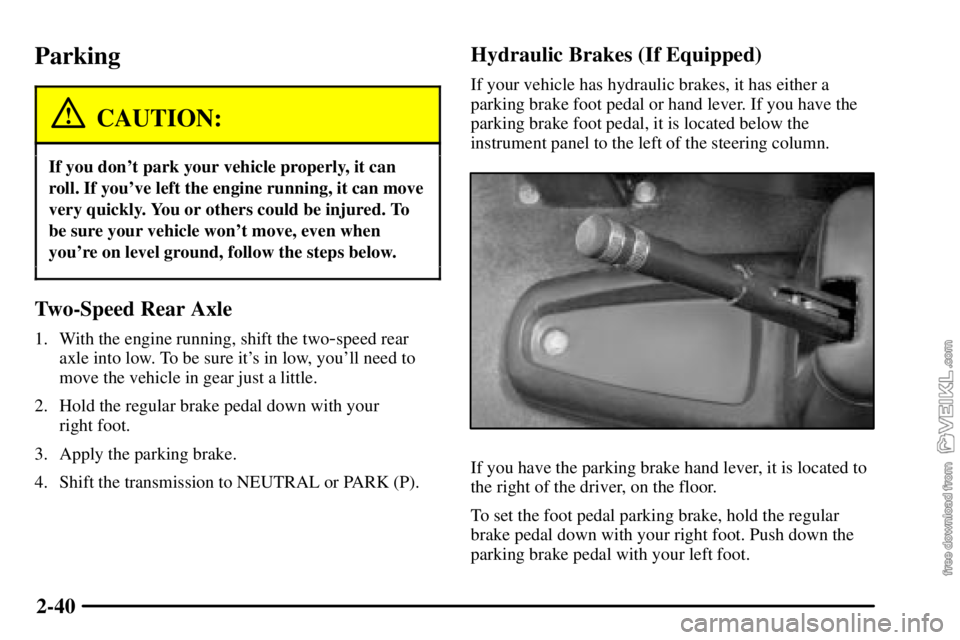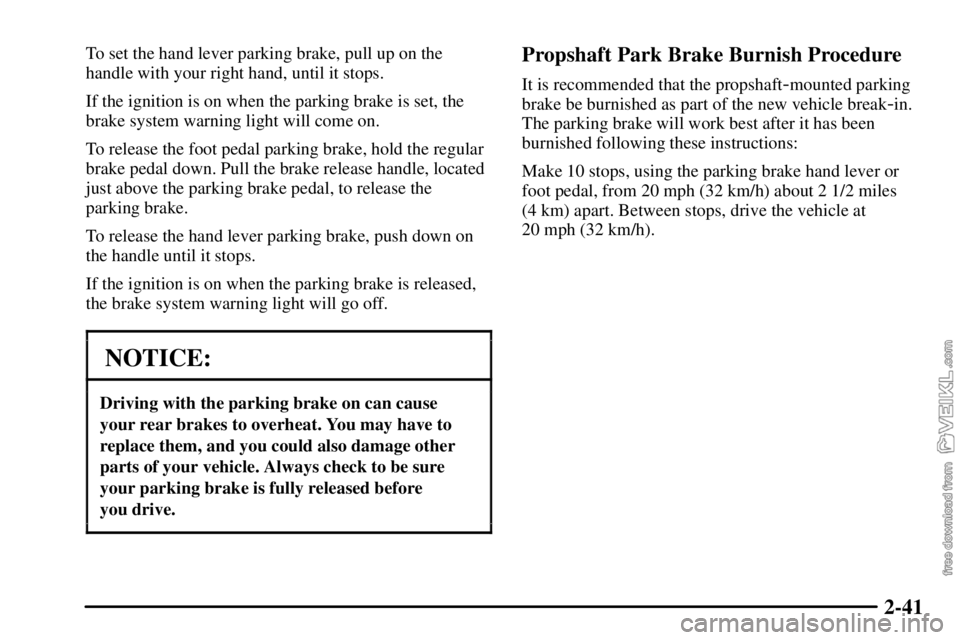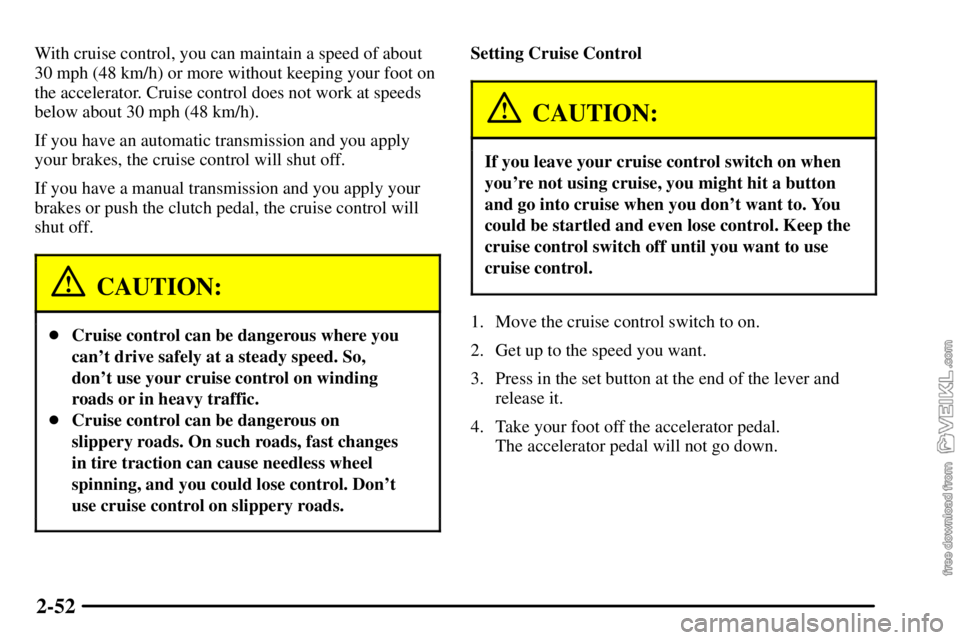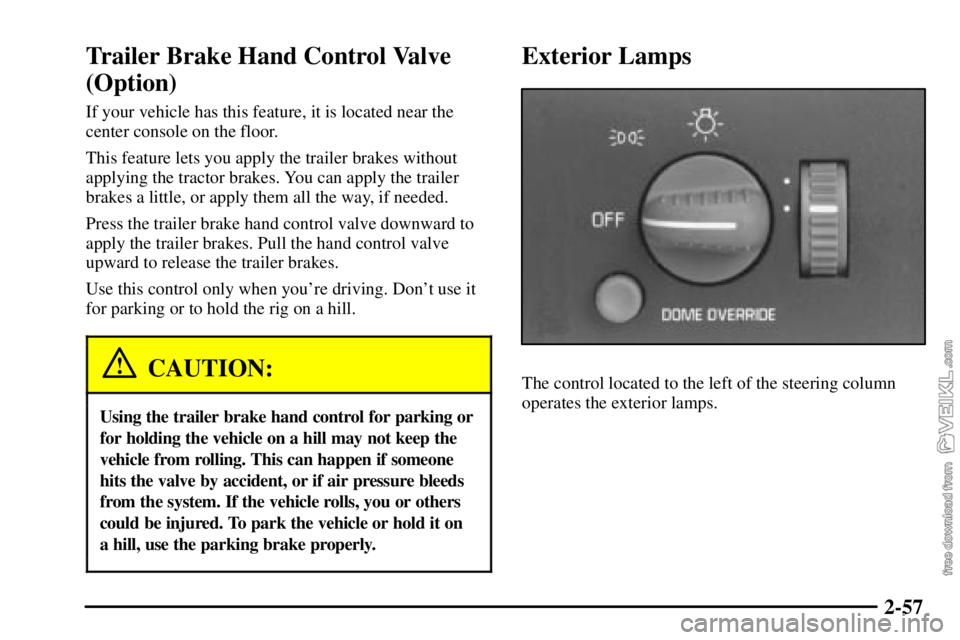Page 102 of 386

2-27
Engine Checks Before Operating
When you've started your engine, let it run for 20 to
30 seconds before you put a load on the engine. But
don't leave the vehicle while the engine is running.
Avoid unnecessary idling of diesel engine equipped
vehicles.
If the engine idles too long, the temperature of the
engine coolant will fall below the normal operating
range. Low engine operating temperature causes several
conditions which affect engine operation and reduce
engine life.
The engine should be permitted to go through a
warm
-up period. Operate the vehicle at a minimum of
600 rpm during the warm
-up period. During this period
and during operation, the following observations should
be made.
During this warm
-up period, check your warning lights
and gages:
�If oil pressure doesn't begin to rise within
15 seconds of starting, stop the engine and
find the cause.�If the engine coolant temperature gage needle goes
into the hot area on the gage, stop the engine and
find the cause of the overheating.
�If you have air brakes, the dual
-needle air pressure
gage should read at least 115 psi (790 kPa) for both
service systems before you try to move the vehicle.
When air pressure is below 60 psi (420 kPa), the
LOW AIR light will come on and you will hear a
tone alarm. If the pressure doesn't build up or
drops during warm
-up, stop the engine and find
the cause before you try to move the vehicle.
Recommended air pressure before actually driving
away is 120 psi (830 kPa).
�The charging system light should come on when
the ignition key is turned to RUN or START and
should go out when the engine is running above idle.
If the light doesn't go out or comes back on during
normal engine operation, have the charging system
checked right away. (This light tells you if the
generator is not charging; it doesn't reflect the
condition of the battery.)
Page 105 of 386

2-30
Diesel Engine Exhaust Brake
(If Equipped)
The exhaust brake is available on vehicles equipped
with a diesel engine. It is located in the exhaust system.
The exhaust brake is used to help slow the vehicle and
may assist the vehicle's foundation brakes. The use of
the exhaust brake will assist the braking of the vehicle
and prolong the life of the foundation brake lining
material.
The exhaust brake switch is
located in the instrument
panel switchbank.Push the bottom of the switch to turn the exhaust brake
on. When you push the top of the switch, the exhaust
brake will turn off.
There is an indicator light on the instrument panel
similar to the symbol on the switch, that will come on
when the exhaust brake is active. See ªExhaust Brake
Indicator Lightº in the Index for more information.
When using the exhaust brake, the proper gear range
selection is important. The exhaust brake will be most
effective if the gear range selected is the lowest possible
range that does not allow the engine rpm to go more
than 200 rpm above rated (full load) rpm. If you have a
Caterpillar diesel engine, do not exceed 2900 rpm. If
you have a DURAMAX (LG4) diesel engine, do not
exceed 3200 rpm. If you have a DURAMAX (LB7)
diesel engine, do not exceed 3600 rpm.
If you have an automatic transmission and press this
button, the transmission will downshift to a factory
default setting of fourth gear. To change the default
setting, or for more information on factory default
settings, contact your dealer for assistance.
Page 115 of 386

2-40
Parking
CAUTION:
If you don't park your vehicle properly, it can
roll. If you've left the engine running, it can move
very quickly. You or others could be injured. To
be sure your vehicle won't move, even when
you're on level ground, follow the steps below.
Two-Speed Rear Axle
1. With the engine running, shift the two-speed rear
axle into low. To be sure it's in low, you'll need to
move the vehicle in gear just a little.
2. Hold the regular brake pedal down with your
right foot.
3. Apply the parking brake.
4. Shift the transmission to NEUTRAL or PARK (P).
Hydraulic Brakes (If Equipped)
If your vehicle has hydraulic brakes, it has either a
parking brake foot pedal or hand lever. If you have the
parking brake foot pedal, it is located below the
instrument panel to the left of the steering column.
If you have the parking brake hand lever, it is located to
the right of the driver, on the floor.
To set the foot pedal parking brake, hold the regular
brake pedal down with your right foot. Push down the
parking brake pedal with your left foot.
Page 116 of 386

2-41
To set the hand lever parking brake, pull up on the
handle with your right hand, until it stops.
If the ignition is on when the parking brake is set, the
brake system warning light will come on.
To release the foot pedal parking brake, hold the regular
brake pedal down. Pull the brake release handle, located
just above the parking brake pedal, to release the
parking brake.
To release the hand lever parking brake, push down on
the handle until it stops.
If the ignition is on when the parking brake is released,
the brake system warning light will go off.
NOTICE:
Driving with the parking brake on can cause
your rear brakes to overheat. You may have to
replace them, and you could also damage other
parts of your vehicle. Always check to be sure
your parking brake is fully released before
you drive.
Propshaft Park Brake Burnish Procedure
It is recommended that the propshaft-mounted parking
brake be burnished as part of the new vehicle break
-in.
The parking brake will work best after it has been
burnished following these instructions:
Make 10 stops, using the parking brake hand lever or
foot pedal, from 20 mph (32 km/h) about 2 1/2 miles
(4 km) apart. Between stops, drive the vehicle at
20 mph (32 km/h).
Page 117 of 386
2-42 Air Brake (If Equipped)
CAUTION:
When the yellow SYSTEM PARK and the red
TRAILER AIR SUPPLY knobs are both pushed
in, your rig will be free to move. It could strike
someone or something. When both of these knobs
are pushed in, hold the regular brake pedal down
to keep your rig from moving.
If your vehicle has air
brakes, you will have this
parking brake. It is located
above the radio in the
instrument panel.
Pulling it out applies the parking brake. The park brake
light will come on when the air parking brake is applied.
Page 119 of 386

2-44
CAUTION:
If you apply any one of the air brake parking
controls while the vehicle is moving, your rig will
stop suddenly. If you are not ready for this, you
or others could be injured. Don't apply any one
of these controls while you're driving, unless you
have to make an emergency stop.
If the air pressure drops below 60 to 70 psi (413 to
482 kPa), the primary brake light and warning buzzer
will come on. If the air pressure drops to 35 to 45 psi
(241 to 310 kPa), the red trailer air supply knob will
automatically pop out and apply the spring brakes on
the trailer.If the air pressure drops to 35 to 45 psi (241 to 310 kPa),
the yellow park brake knob will automatically pop out
and apply the spring brakes on the truck or tractor.
If you ever have a complete loss of air so that your air
brakes automatically apply, there is a way that the tow
operator can release the parking brakes to tow the
vehicle. See ªTowing Your Vehicleº in the Index.
CAUTION:
If your vehicle is left in gear, the engine can start
if the vehicle starts to roll. This can easily happen
if you have the diesel engine. Shift the
transmission into NEUTRAL (N) before you
leave the vehicle.
Page 127 of 386

2-52
With cruise control, you can maintain a speed of about
30 mph (48 km/h) or more without keeping your foot on
the accelerator. Cruise control does not work at speeds
below about 30 mph (48 km/h).
If you have an automatic transmission and you apply
your brakes, the cruise control will shut off.
If you have a manual transmission and you apply your
brakes or push the clutch pedal, the cruise control will
shut off.
CAUTION:
�Cruise control can be dangerous where you
can't drive safely at a steady speed. So,
don't use your cruise control on winding
roads or in heavy traffic.
�Cruise control can be dangerous on
slippery roads. On such roads, fast changes
in tire traction can cause needless wheel
spinning, and you could lose control. Don't
use cruise control on slippery roads.
Setting Cruise Control
CAUTION:
If you leave your cruise control switch on when
you're not using cruise, you might hit a button
and go into cruise when you don't want to. You
could be startled and even lose control. Keep the
cruise control switch off until you want to use
cruise control.
1. Move the cruise control switch to on.
2. Get up to the speed you want.
3. Press in the set button at the end of the lever and
release it.
4. Take your foot off the accelerator pedal.
The accelerator pedal will not go down.
Page 132 of 386

2-57
Trailer Brake Hand Control Valve
(Option)
If your vehicle has this feature, it is located near the
center console on the floor.
This feature lets you apply the trailer brakes without
applying the tractor brakes. You can apply the trailer
brakes a little, or apply them all the way, if needed.
Press the trailer brake hand control valve downward to
apply the trailer brakes. Pull the hand control valve
upward to release the trailer brakes.
Use this control only when you're driving. Don't use it
for parking or to hold the rig on a hill.
CAUTION:
Using the trailer brake hand control for parking or
for holding the vehicle on a hill may not keep the
vehicle from rolling. This can happen if someone
hits the valve by accident, or if air pressure bleeds
from the system. If the vehicle rolls, you or others
could be injured. To park the vehicle or hold it on
a hill, use the parking brake properly.
Exterior Lamps
The control located to the left of the steering column
operates the exterior lamps.